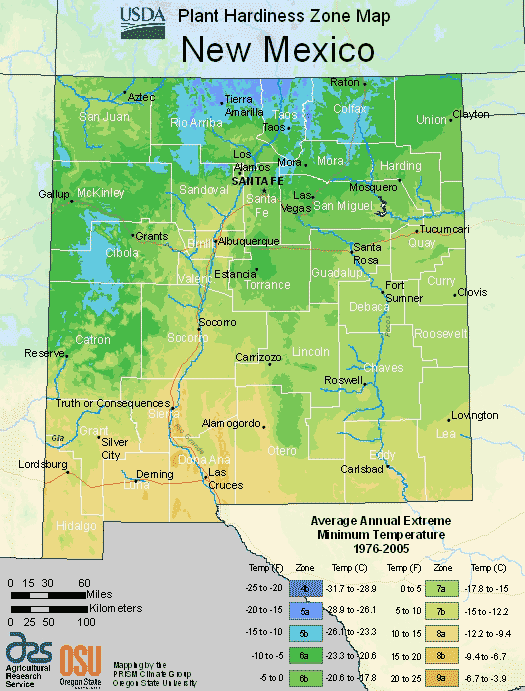
Table of Contents
Characteristics of New Mexico Planting Region
In New Mexico, extreme weather is common, including hurricanes, heavy rains, and hot spells.
Despite its sunny disposition, New Mexico’s lofty elevation and arid atmosphere limit the growing season to 150 frost-free days on average.
The findings suggest that climate change is having an increasingly significant impact on the biodiversity of the planet.
The research indicates climate change is having a growing effect on the world’s biodiversity.
Challenges of Growing in New Mexico
1. Intense Droughts
New Mexico’s climate is predominantly dry and hot, leading to little rainfall and low humidity. Droughts and heat waves are frequent, so selecting heat-tolerant, drought-resistant plants for outdoor cultivation is key.
2. Dry Air
The dry air in New Mexico can pose challenges for gardening as it leads to rapid evaporation of moisture from the soil, making it challenging to maintain consistent hydration for plants. Gardeners in New Mexico need to focus on water-wise practices such as mulching, drip irrigation, and selecting drought-tolerant plants to thrive in the arid climate.
3. High Altitude
New Mexico is among the most elevated states in the United States. Outdoor gardening can be difficult due to its unpredictable seasons, wild weather, subpar soil, and potential for frost year-round. A greenhouse can help control temperatures and shield plants from such issues.
Vibrant Landscapes: Best Plants for New Mexico’s Planting Zone
With careful consideration of the climate and water availability, here are some of the best plants to grow in New Mexico’s planting zone:
1. New Mexico False Yucca (Hesperaloe funifera): As a native succulent, the New Mexico False Yucca is well-adapted to the arid conditions of the state. This dramatic plant features tall flower spikes with creamy white blooms, adding a touch of elegance to xeriscape gardens.
2. Apache Plume (Fallugia paradoxa): This hardy, native shrub thrives in New Mexico’s dry environment. Apache Plume produces delicate white flowers with feathery pink seed heads, creating a stunning display and attracting pollinators.
3. Santa Fe Cholla (Cylindropuntia viridiflora): This cactus species is native to New Mexico and features cylindrical stems adorned with beautiful yellow flowers. The Santa Fe Cholla adds a unique Southwestern charm to desert landscapes.
4. Russian Sage (Perovskia atriplicifolia): Russian Sage is a popular choice for New Mexico gardens due to its drought tolerance and striking silvery-gray foliage. The lavender-blue flowers provide a splash of color and attract pollinators.
5. Desert Marigold (Baileya multiradiata): As a native perennial, Desert Marigold is well-suited to New Mexico’s planting zone. With its bright yellow flowers and long bloom period, this plant adds a cheerful touch to any desert garden.
6. Blackfoot Daisy (Melampodium leucanthum): This low-growing, drought-tolerant perennial is an excellent choice for New Mexico’s gardens. Blackfoot Daisy produces charming white daisy-like flowers that bloom throughout the warm months.
7. Pinyon Pine (Pinus edulis): Pinyon Pine is a native evergreen tree that thrives in New Mexico’s higher elevations. It provides essential habitat and food for wildlife, and its distinctive pine nuts have been a valuable food source for Indigenous communities.
8. Rocky Mountain Penstemon (Penstemon strictus): With its striking blue-purple flowers, Rocky Mountain Penstemon is a delightful addition to New Mexico gardens. This native perennial attracts pollinators and adds vibrant color to the landscape.
9. New Mexico Privet (Forestiera neomexicana): This native shrub is well-suited to New Mexico’s dry climate. It features small yellow flowers and provides an excellent choice for hedges or as a foundation plant.
10. Agave (Agave spp.): Agave species are iconic desert plants that thrive in New Mexico’s planting zone. With their distinctive rosette forms and various sizes and shapes, they add a sculptural element to xeriscape gardens.
To ensure successful gardening in New Mexico, it’s essential to consider the region’s arid climate and limited water resources. Xeriscaping, a landscaping approach that focuses on water conservation, is particularly popular in the state. Choosing drought-tolerant and native plants is essential for reducing water usage and promoting sustainable gardening practices.
In regions with higher elevation and colder winters, it’s crucial to select plants that can withstand freezing temperatures. Adequate mulching and protection measures can help plants survive the winter months.
Watering practices should be adjusted to the specific needs of each plant and the prevailing weather conditions. Drip irrigation systems and rainwater harvesting can be employed to ensure efficient water use.
In conclusion, New Mexico’s planting zone offers a wealth of plant choices for gardeners seeking to create vibrant and water-wise landscapes. From the unique allure of desert natives like the New Mexico False Yucca and Apache Plume to the classic charm of Russian Sage and Rocky Mountain Penstemon, the best plants for New Mexico gardens celebrate the state’s natural beauty and complement its distinctive Southwestern character. By embracing drought-tolerant species and sustainable gardening practices, enthusiasts can enjoy flourishing gardens that harmonize with the desert surroundings and provide a habitat for native wildlife.
